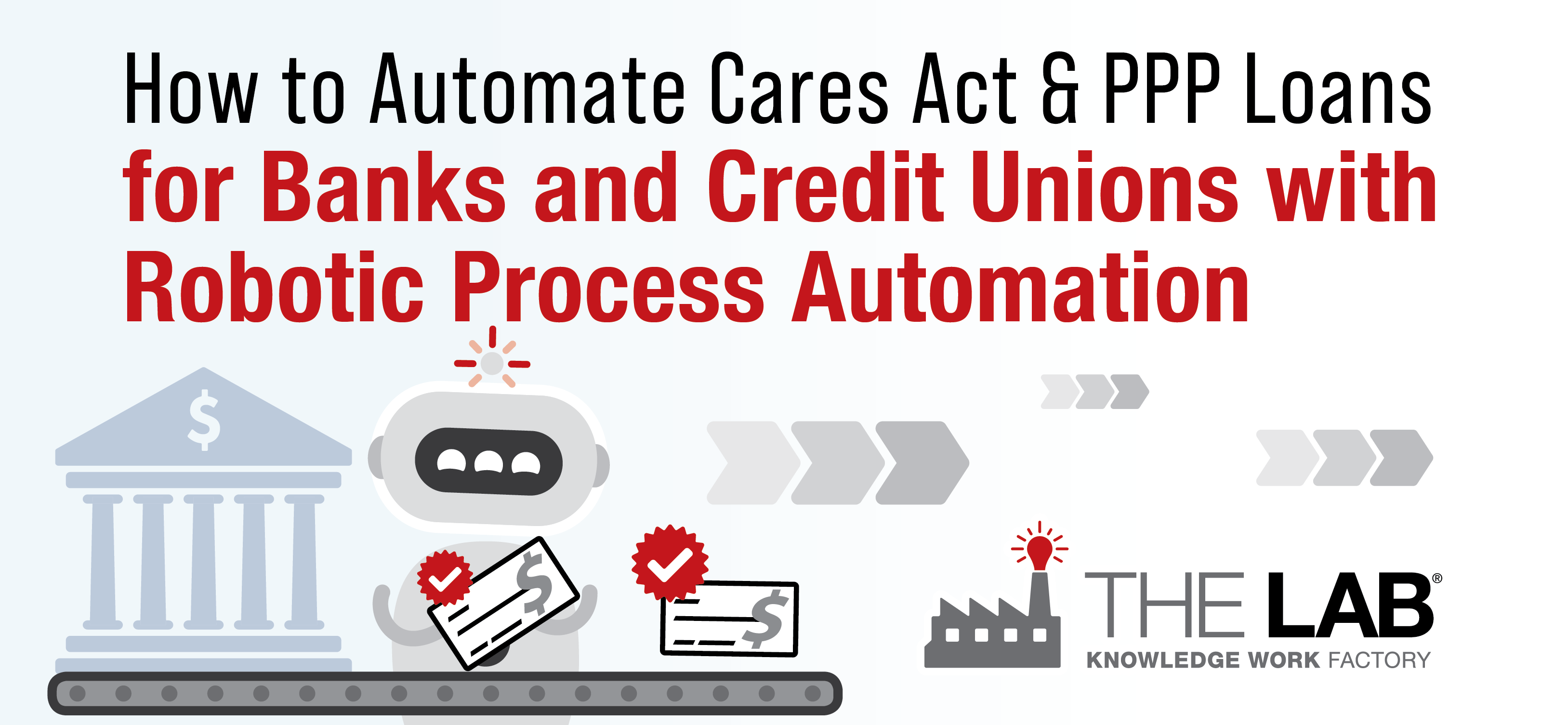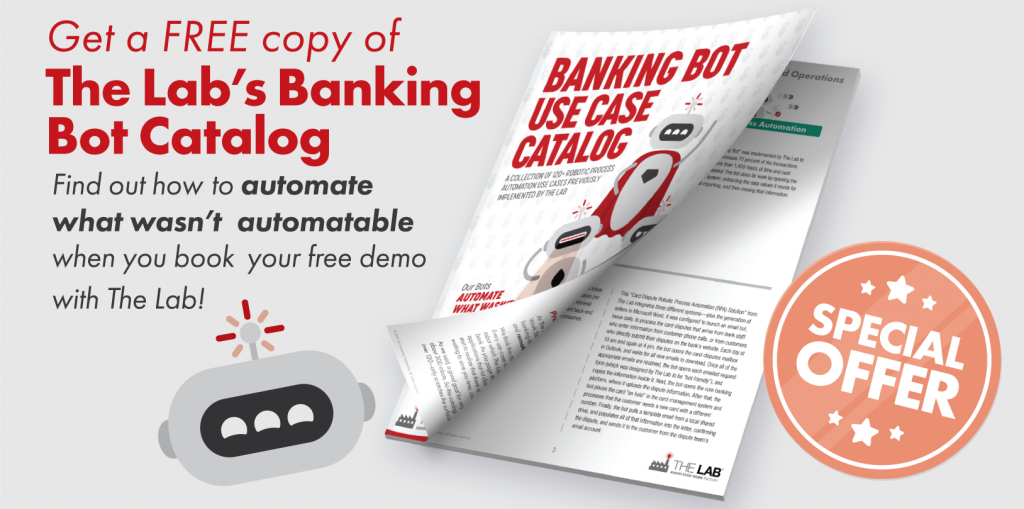Historic stimulus loans will overwhelm banks and credit unions that fail to automate the intake, approval, and administrative processes for SBA and Paycheck Protection Program loans
The federal government just enacted the largest stimulus package in the history of the United States: the CARES Act. It includes a wide range of grants, tax breaks, direct cash payments to people who are forced to stay home, and loans to businesses. These new business-loan options include disaster loans, which are paid directly by the U.S. Small Business Administration, or SBA. The other big loan option just coming to market is the SBA Paycheck Protection Program. These loans—the subject of the article—come from banks, and are backed by the federal government.
The scale of the Paycheck Protection Program, or PPP, is as staggering as it is unprecedented: A full $350 billion in Paycheck Protection Program SBA loans is becoming available to all businesses with fewer than 500 employees. And it will be rolled out in a quarter, perhaps sooner.
To put that in $350 billion in perspective, consider this: For all of 2019, the SBA issued just $28.2 billion in loans. These went to 63,500 small businesses.
Now let’s do some basic math to calculate the potential inbound loan volume:
- For all of 2019: Divide approximately $28 billion in annual loan volume by four quarters. This amounts to about $7 billion in SBA loans per quarter.
- For COVID-19 in 2020: With the Paycheck Protection Program in place, the SBA will grant some $350 billion in loans in just one quarter.
- Do the math: $350 billion in one quarter vs. $7 billion in one quarter represents a 50x increase.
And that’s just the dollar amount. Now consider the sheer number of actual, individual loans that will be headed your way:
- For all of 2019, the SBA issued 63,500 loans. Divide that by four quarters, and you get 15,875 SBA loans processed per quarter under normal circumstances.
- For COVID-19 in 2020, given the 50-fold increase noted above, you end up with the potential for 793,750 loans to be processed over the next two or three months
Now it’s time for any bank or credit union facing down the tsunami of new SBA and PPP loans to ask themselves some hard, yet realistic, questions:
- Could your bank or credit union process 50 times more loans than it does all year, in the next quarter?
- Could you increase your SBA loan-admin staff by a factor of 50 in a matter of weeks?
Obviously, the answers for any bank or credit union today, regardless of size or SBA prowess, is “No” and “No.”
What is CARES Act and Paycheck Protection Program Automation for Banks and Credit Unions? And why is automating SBA loan processing so important at this moment in history?
We mentioned “banks of all sizes” above. But that was actually (and somewhat intentionally) misleading. That’s because most of this $350 billion in urgent, keep-the-business-afloat loan activity is expected to go through mid-sized banks and financial-services institutions.
Let us make this clear: This program does not connect small businesses directly to the SBA. Rather, the federal government, through the SBA, will back the loans, but the loans themselves will be processed by the banks. This puts the burden of processing all these loans—perhaps nearly 800,000 of them—on the banks and credit unions.
Simply put, this is beyond the human processing power of banks, no matter how much they’re able to staff up with these specialized personnel. That’s why automation of as many of the CARES Act Paycheck Protection Program SBA loans as possible is critical at this point in history. It’s not just for the banks and credit unions who must process this unprecedented mountain of virtual paperwork. It’s for the country’s lockdown-devastated small business owners and their employees and families, all of whom desperately need cash, right now, just to stay afloat.
Fortunately, there is a silver lining. And that’s automation of CARES Act Paycheck Protection Act loans and automating SBA loans for other urgent applications. Robotic process automation or RPA, has come a long way; during normal times, it presents banks with exciting new tools for speeding back-office operations. During extraordinary times, such as those we’re confronting right now, it’s not even an option. Automating loan processing for banks and credit unions must be done, in order to cope with the onslaught of new applications that’s on its way.
Origination feeds paid to lenders are significant. The more loans you can process, with less human headcount, the more money you will make.
Origination fees paid to lenders for PPP loans are as follows:
- 5% for loans of $350k and less
- 3% for loans over $350k up to $2 million
- 1% for loans $2 million and over
What are the Automation Options for CARES Act Paycheck Protection Program Loans?
For banks and credit unions, there are only three real options:
- Wait for your core platform provider to come out with a solution. But, to date, neither FIS, Fiserv, nor Jack Henry has been able to even integrate the varied pieces of their own systems. So it’s hard to put much stock in Option 1, let alone in an urgent timeframe.
- Buy a new SBA loan-processing platform, which will take six months to install. While you’re waiting (and frantic businesses are ringing your phones off the hook), try and increase your back-office SBA loan-processing staff so it’s 50 times larger than it is right now. By the way, that “six months’ worth” of coding and software configuration required for the installation all takes place in India—and India is all but shut down.
- Install robotic process automation (RPA) bots, in just weeks. These bots can be implemented in a quick and agile manner, within a few weeks, to bridge gaps between systems that only humans previously could. And they can be installed remotely, too.
Do we have your attention now? Armed with CARES Act and SBA loan automation via RPA robotic process automation robots, you can proceed to the solution described below.
Why do you need to automate CARES Act and Paycheck Protection Program loan processing?
You can’t just plug in a new system to solve this problem that is about to hit. You have to quickly connect your existing work flow to the SBA website… but right now, the only way to do that is with humans in the middle—or robotic process automation.
The robots are actually little software programs that are able to “sit at a computer” and mimic the repetitive activities that humans do at their computers: Open files, navigate to sites, log in, copy information from one field or system and paste it into another, and so on. Only they do it with lightning speed, and never get tired, take breaks, or make mistakes. In fact, humans love them! They take a ton of overwhelming drudge-work off their plates.
The need for “robots in the middle” has never been greater. In case you haven’t checked the job boards like Indeed and LinkedIn, they are already swarmed by banks looking for SBA loan processors. The demand for labor to solve this inbound loan volume is here, now. And it’s only going to increase; it’s a classic case of demand outstripping supply. In other words, brace yourself for a massive shortage of experienced labor to process these kinds of loans.
An automated solution to processing Paycheck Protection Program loans from the CARES Act
The Lab Consulting’s Houston, Texas-based RPA team is developing a suite of Robotic Process Automation bots to help our banking and credit-union clients process the soon-to-be inbound flood of Paycheck Protection Program loans from the CARES Act. Among the “bots” that we are creating, include those dedicated to the overwhelming, yet tedious and predictable activities of:
- Inbound loan forms processing
- Underwriting
- Processing deferral requests
- Sending “paperwork” to SBA
How do you automate Paycheck Protection Program loan processing with robotic process automation?
It’s simple. You install a suite of bots that take care of three strategic chunks of work, where you have the biggest gaps in your current work force.
Note that you will not have to update any of your core applications for this to help your bank. The suite includes:
Robotic Process Automation Bot 1: Inbound CARES Act and Paycheck Protection Program Loan Application Form Processing.
This bot will scrape the inbound SBA forms from customers and automatically move that data into any core systems from all major providers (FIS, Fiserv, Jack Henry). Historical SBA 1919 forms (the form to submit an SBA loan) have lent themselves well to data-scraping, due to their editable PDF field format. These can be straight-through processed by a bot into your core lending system with ease.

A copy of the Paycheck Protection Program form is shown below; it’s similar, with editable fields that can easily be moved via bot automation into your core system in seconds. That large stack of inbound forms can be cut much quicker with RPA, when compared to a human.
 Robotic Process Automation Bot 2: CARES Act and Paycheck Protection Program Underwriting Decisioning Bot.
Robotic Process Automation Bot 2: CARES Act and Paycheck Protection Program Underwriting Decisioning Bot.
This bot will make underwriting decisions and automatically “hard decline” loan requests that don’t meet basic SBA PPP loan criteria.
The SBA criteria for approving a Paycheck Protection Program loan are binary; i.e., if the loan meets very basic criteria, it is instantly 100 percent approved without additional underwriting.

A bot can easily sift and sort through large amounts of applications in short amounts of time. As the bot works through the pile of applications, it can accept or reject applications based on the SBA set criteria below:
- Is the business employing fewer than 500 employees? Yes, accept. No, reject.
- Was the business applying in business on February 15, 2020? Yes, accept. No, reject.
- Did the business have employees, or contractors, and paid salaries on February 15, 2020? Yes, accept. No, reject.
- Will loan proceeds be used for payroll costs, healthcare benefits, rent, utilities, or mortgage? Yes, accept. No, reject.
- Good faith certification submitted with loan? Yes, accept. No, reject.
Robotic Process Automation Bot 3: Cares ACT and Paycheck Protection Programs 6 Month Existing SBA Loan Deferral Automation Bot.
The CARES Act allocated $17 billion to subsidize current SBA loans. For loans in regular service, the SBA will pay the principal, interest, and fees owed for six months. The SBA also will pay six months’ worth of principal, interest, and fees for new SBA loans made between March 27, 2020, and September 27, 2020.

This means that bank’s entire existing SBA portfolio may send requests to defer payments via the SBA. The PDF deferral forms and documentation will have to be submitted similarly to a new loan application, loaded into your core system, and pushed through to the SBA platform for processing.
The only current solutions for this are human workers. However, RPA bots can do the work in the exact same flow as a human, and much faster.
Robotic Process Automation Bot 4: SBA Form and Paperwork Submission Bot to SBA E-tran Portal
This bot will take the approved PPP loan data in your core system and input it into the SBA data portal automatically.

We anticipate an implementation time for this “bot suite” to be five to eight weeks.
To learn more about this revolutionary suite of loan-processing automation opportunities for banks and credit unions, please call (201) 526-1200 or email info@thelabconsulting.com to book a free, no-obligation 30-minute screen-sharing demo today.
For 2021: We have updated our bank client offering. Much of these findings and implementation results can be reviewed in the 3-part-series of “Big Rocks for Banks” below. Find out how to strategically lower costs, increase operating leverage, improve customer experience, and automate what previously wasn’t automatable in your bank.
Find them all here:





















